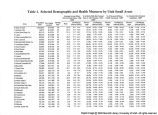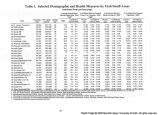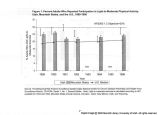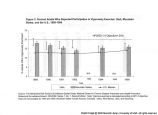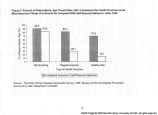| OCR Text |
Show Table 2. Inpatient Admission as a Missed Opportunity for Vaccination* 1994 1995 1996 Percent pneumonia admissions occurring during January-April preceded by any admission during previous year (overall=32.9%) 32.7% 31.8% 34.4% Percent pneumonia admissions occurring during January-April preceded by any admission during October-December of previous year(overall=13.7%) 12.9% 12.5% 15.6% *Utah facilities only, Utah beneficiaries age 65+. Strategies for Improving Vaccine Use Many strategies have been tested for effectiveness in inpatient and outpatient settings to improve the delivery of influenza and pneumococcal vaccine to elderly adults. Gyorkos et al. (1994) reviewed 377 published studies which reported effectiveness in vaccine delivery. Twenty-four publications on influenza vaccine and 11 on pneumococcal vaccine met the selection criteria (use of control groups, studies done on humans in developed countries). The target population was mostly >65 years of age; study designs, settings, and interventions varied, but the largest intervention effects were seen in the inpatient setting with system-oriented interventions such as standing orders or policies and procedures to ensure immunization. A hospital-based, system-oriented intervention consisted of an infection control nurse screening patients on the day of discharge for candidacy for pneumococcal vaccine, providing information about the vaccine, and administering the vaccine. Compared to a control group on another inpatient unit who was not offered the vaccine, a 78% increase in pneumococcal vaccine delivery was achieved (p=0.001) (Klein and Adachi, 1986). In another hospital-based intervention with standing orders for influenza vaccine (which consisted of orders for the patient nurse to assess the need for the vaccine, review the indications, and administer the vaccine), 95.2% of patients were offered vaccination compared to 22% of patients when physicians were exposed only to chart reminders, and less than 12% of patients when education strategies were offered to physicians (Crouse, Nichol, Person, Grimm, 1994). Fieback and Beckett (1994) also found in their review that interventions targeted at inpatients with standing orders and patient education and follow-up achieved vaccination results of 75-95%. Use of Medicare Data to Measure Improvement Outcomes If standing orders are put in place, Utah Part B Medicare claims data can be used to determine whether they result in increased vaccination delivery. These data can be provided to individual hospitals to indicate the success of their interventions. Part A data can be used to determine whether the ultimate desired outcomes of decreased pneumonia hospital izations and pneumonia-related mortality occur, for a hospital population, the Utah Medicare population, or for a specific patient. Conclusion The potential for every health care encounter to include disease prevention interventions has so far not been realized. Acute care facilities should expand traditional prevention activities, like health fair screenings, to include the acute hospitalization episode. A hospitalization for Medicare beneficiaries is an opportunity for vaccination for the preventable causes of pneumonia in a high risk population. System-oriented interventions, such as standing orders, have the best effectiveness in improving vaccine delivery. References CDC. (February 16, 1996). Defining the Public Health Impact of Drug-Resistant Streptococcus Pneumoniae: iteport of a Working Group. Morbidity and Mortality Weekly Report, 45(RR-1), 1-20. CDC. (May 3, 1996). Prevention and Control of Influenza: Recommendations of the Advisory Committee on Immunization Practices. Morbidity and Mortality Weekly Report, 45(RR-5), 1-25. CDC. (April 4, 1997). Prevention of Pneumococcal Disease: Recommendations of the Advisory Committee on Immunization Practices. Morbidity and Mortality Weekly Report, 46(RR-8), 1-25. CDC. (October 3, 1997). Missed Opportunities for Pneumococcal and Influenza Vaccination of Medicare Pneumonia Inpatients-12 Western States, 1995. Morbidity and Mortality Weekly Report, 46(39), 919-923. CDC. (October 3, 1997). Pneumococcal and Influenza Vaccination Levels among Adults Aged 60 |









































